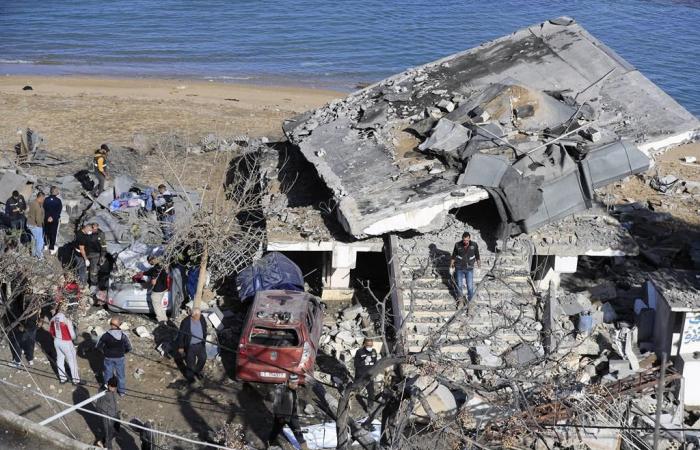The development came as an airstrike hit the historic Syrian city of Palmyra, killing 36 people, according to Syrian state media, which blamed Israel for the attack. The Israeli military declined to comment.
Israeli Defense Minister Israel Katz and Foreign Minister Gideon Saar both indicated that Israel was seeking to reserve the right to respond to any Hezbollah violations under an emerging proposal, which would push the militant group’s fighters and Israeli ground forces out of a United Nations (UN) buffer zone in southern Lebanon.
There were signs of progress on the ceasefire deal, with Hezbollah’s allies in the Lebanese government saying the militant group had responded positively to the proposal.
“In any agreement we manage to reach, we will have to maintain our freedom of action in the event of violations,” Mr. Saar told dozens of foreign ambassadors in Jerusalem. “We will have to be able to act in time, before the problem gets worse.”
In a meeting with intelligence officers, Minister Katz mentioned that “the condition for any political settlement in Lebanon” was the right of the Israeli army “to act and protect Israeli citizens from Hezbollah.” .
Amos Hochstein, the Joe Biden administration’s key man on Israel and Lebanon, has worked in recent days to push the parties toward an agreement. He met with officials in Lebanon this week and said Wednesday he would travel to Israel to try to “end this war if we can.”
Mr. Hochstein argued Tuesday that an agreement to end the war between Israel and Hezbollah was “within our reach.” The emerging ceasefire agreement would push Hezbollah and Israel out of southern Lebanon.
Hezbollah began firing into Israel on October 8, 2023, in solidarity with Hamas after its attack on southern Israel that sparked the war in the Gaza Strip. Israel responded with strikes in Lebanon and significantly intensified its bombing in late September by launching a ground invasion just inside the border.
During these exchanges which lasted more than a year, more than 3,500 people were killed in Lebanon, most in the last month, the Health Ministry reported, and more than a million people were displaced. It was not specified how many of the dead were Hezbollah fighters.
In Israel, more than 70 people have been killed by Hezbollah fire and tens of thousands have fled their homes.
Mr Hochstein’s proposal is based on UN Resolution 1701, which ended the 2006 war between Hezbollah and Israel. The resolution states that only the Lebanese army and UN peacekeepers should operate in southern Lebanon.
Yet after 2006, Hezbollah never completely ended its presence in the south. Lebanon accuses Israel of also violating the resolution by maintaining control of a small disputed border area and carrying out frequent military flights over Lebanon.
Israel claims that Hezbollah has since built military infrastructure in villages and towns in southern Lebanon.
The proposal currently under discussion would include a settlement plan and monitoring system to ensure each side meets its obligations to completely withdraw from the south. This could involve the United States and France, but the details are not yet clear.
Progress, but no agreement yet
Israeli ministers did not specify what Israel’s request to maintain the right to operate would entail. Since the 2006 war, Israel has struck Hezbollah on the rare occasions when border violence has erupted, but any larger-scale response could plunge the region back into turmoil.
Lebanon is also unlikely to accept a deal that allows Israeli violations of its sovereignty. And although the proposal attempts to establish a settlement mechanism, the failure to fully implement the UN resolution after the 2006 war could highlight the difficulties in getting parties to respect a lasting ceasefire that would bring long-term peace.
Israel continued to pound Hezbollah throughout the ceasefire attempts and rockets continued to rain down on northern Israel. Any perceived escalation could derail negotiations.
The war would continue even with a ceasefire
Even if a ceasefire between Israel and Hezbollah is reached, the war in the Gaza Strip is in its 14th month.
Israel is still fighting Hamas there, pushing the death toll to nearly 44,000 – more than half of whom are women and children, according to local health authorities, who do not distinguish between civilians and combatants in their count. .
While Hezbollah declared throughout the war in the Gaza Strip that it would not stop firing at Israel until fighting in the Palestinian territory ended, this condition was abandoned in September after Israel has intensified its offensive against the militant group, killing its top leaders and degrading its military capabilities.
This leaves the Gaza Strip awaiting a ceasefire from it, as the population continues to endure a humanitarian crisis that has displaced many of the territory’s 2.3 million residents and caused famine. widespread.
International mediation efforts have repeatedly been blocked due to disagreement between Israel and Hamas over whether the war should end under a ceasefire, with Israel insisting that he wants to maintain the presence of troops in certain areas.
Other tumultuous parts of the Middle East are unlikely to be affected by a ceasefire between Hezbollah and Israel, including Syria.
Israel frequently targets military sites and installations associated with Iran-linked groups in Syria, but rarely acknowledges the strikes.






